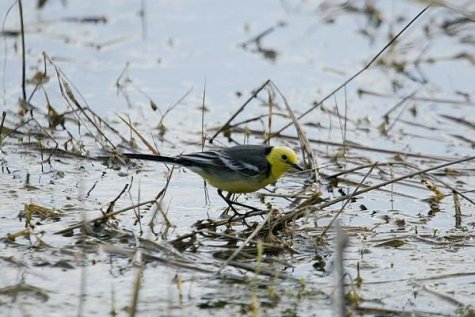Birder - summary of April
Birder Margus Ots, Linnuvaatleja.ee
Photo: Arne Ader
Translation: Liis
Citrine wagtail
In April new arrivals already reached Estonia in greater numbers and 70 species were added to my year list during the month. Altogether my 2012 year list had 206 bird species as of the end of April. A number of difficult species were added too. Most troublesome was the willow ptarmigan; I had to visit East Virumaa several times for it before I finally got to hear the bird. The most successful trip was in Mid-April to Saaremaa where I managed to see the Lapland longspur (4 birds), rock pipit, twite, horned lark, ring ouzel (including the Läänemaa trip finally 6 individual birds seen), green woodpecker (2 birds in different locations), Jack Snipe. Of successful twitchings the European stonechat found in Kabli and the lesser white-fronted geese that stayed in the Matsalu National park have stayed in mind. Among tougher rarities I managed to find the black-necked grebe in two locations: 1 in the Audru polder and 2 at Sutlepa sea. Among the spontaneously found rarities I finally got the red-crested pochard, that we saw at the Valguta polder. Twitching the pochard earlier in Haapsalu did not succeed. Good that I got this difficult species noted. Among the more interesting of the so to say obligatory species I moreover managed to list the marsh sandpiper, citrine wagtail, great snipe, hoopoe and black kite.
But many interesting species stayed unseen too. I didn’t get to twitch the Isabelline shrike found at Sõrve säär at the end of April and the corn bunting. Those birds were not really twitchable, disappeared very quickly. In April pallid harriers were seen in several places, these birds too were on migration and twitching was not really possible. Hopefully I will succeed to find the pallid harrier, sometime. I did go to twitch the red-flanked bluetail seen in Oriküla in Pärnumaa, but I was clearly too late. The king eider was only seen once in April, on migration at Rohuneeme in Harjumaa, and it was not twitchable. At Toomalõuka in Saaremaa a yellow-billed loon was seen, but I did not race to Saaremaa for it because hopefully I will succeed to see them in the best migration period in May at Ristna nina or Põõsaspea cape.
In April my viewing hours ran up to exactly 300 (from the start of the year, 644); kilometres by car were clearly too many , or 6805 (from the start of the year, 18603) and kilometres on foot were 154 in April (from the beginning of the year, 402). I have entered my observations in the e-Biodiversity data base and the map there shows where I have been on trips in April.









